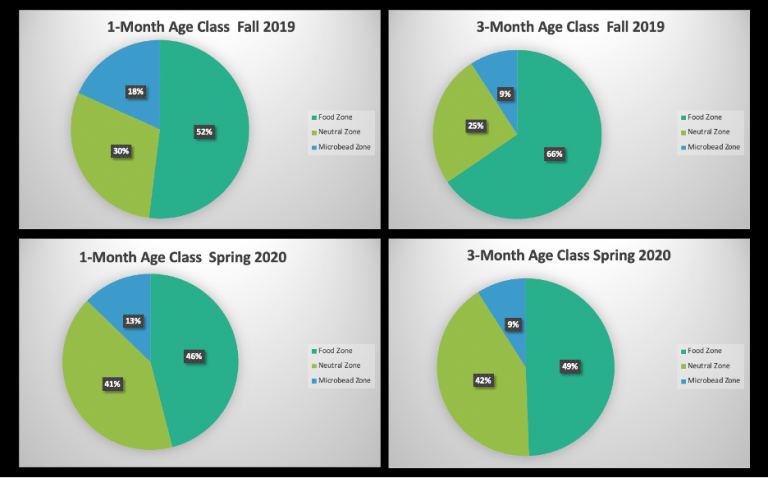Microplastics & Fish Behavior
What's Going on Here?
There is a continuous increase of synthetic plastic production, leading to an accumulation of plastic waste in aquatic environments. Most plastics do not biodegrade; instead they break down into smaller pieces, which eventually are small enough to be called microplastics. Microplastics can be ingested by aquatic organisms who believe them to be food. Some of the physical impacts of ingestion include laceration, inflammation, and in some cases starvation. There have also been cases of increased mortality, significant impacts on offspring, a reduction in feeding activity, and depletion of energy reserves. When an animal of importance within an ecosystem, whether a predator or prey species, is faced with the consequences of microplastic ingestion, the whole ecosystem may suffer from the decreasing population of that species.
Tackling the Problem
Alumni Environmental Science and Biology student, Kendall Wald, had been working in the IC Tox Lab since her sophomore year at IC. She had devoted her time in the lab to analyze fish feeding behavior when encountering microplastics. Over the last couple years, Kendall focused on which of the five senses is contributing to the misidentification of microplastics as food and if fish were able to use their sense of sight and smell to distinguish their food and microplastics.

Steps in the Process to Success

During her first semester in the lab Kendall was introduced to an amazing piece of technology called EthoVision XT, which is a video tracking software that analyzes the behavior and movement of animals. Every semester, Kendall used EthoVision to answer a question about how fish react to microplastics. Individual fish are placed into a tank (aka the arena) with a camera hovering above it for the trials and the camera takes a video from when microplastics are dropped into the tank to when the trial time is complete.
So far, juvenile fathead minnows have been the subjects of the experiments. Two age classes, one-month and three-month were separated and acclimated in their new environment and feeding schedule for two weeks prior to the trials. They were kept in a room at 74°F with a 12-hour light: 12-hour dark cycle and fed twice a day.
For her studies, the EthoVision setup involved splitting the arena into three zones: a food zone and a microbead zone on either side of the tank and a neutral zone in the center. During 90 second trials, the EthoVision calculated how much time the subject spends in each zone, how fast the subject was moving, and how many times the subject moved between the zone.


Using the measurements EthoVision took while live tracking, heatmaps were created to show each subject’s path during the trials and where they spent the most time.
Findings
Her first year in the lab, Kendall’s experiments consisted of mixing microplastics and fish food together to see if the fathead minnows avoided the mixture or ate it despite containing microplastics. In this experiment, the microplastics were blue and the food was brown, but the hypothesis was the minnows would ingest the food because fathead minnows are known for being opportunistic feeders. She found that the fish ate the mixture, choosing not to avoid the microplastics.
The next year, Kendall decided to separate the food and the microplastics into separate zones within the tank to see if the fathead minnows would favor the food over the microplastics. She chose microplastics that were visually similar to the fish food (color, size, and shape). Kendall also incorporated another variable into the experiment. Two groups of fish were tested, a one-month age class and a three-month age class. She hypothesized the fish would not favor one or the other and would feed on both the food and the microplastics. She also hypothesized that the two age classes would show the same feeding pattern. The results did not support this hypothesis. In fact, there was a significant difference in amount of time the fish spent eating or near the food for both age classes. Also, despite both groups favoring the food over the microplastics, the three-month age class favored the food group to a greater extent. This led Kendall to the conclusion that minnows could possibly be using their sense of smell to differentiate between microplastics and food and the sense of smell gets stronger as the fish age. She hypothesizes that minnows learn as they get older how to differentiate between microplastics and food.
Her last project consisted of using the same method of testing; however, it was done with goldfish and zebrafish to see if they demonstrated the same pattern.

Upcoming Research Questions
- Does sense of smell help fish differentiate between food and microplastics?
- Are fish with a stronger sense of smell better at identifying microplastics?
- Do older fish have a greater capability in identifying microplastics than younger fish?
Why This Matters
If there is a strong positive correlation with a fish’s sense of smell and their ability to differentiate between microplastics and food, it would support the hypothesis that a fish’s sense of smell is the determining factor of how well fish can distinguish microplastics from food. If the older age classes are all found to have a stronger ability of differentiating the two materials, the study will identify the greatest impact microplastics have on fish is at the larval and juvenile stages of life. This is because the younger age classes are more vulnerable in terms of ingesting microplastics by mistaking them as food. This study could also explain why there is a difference in fish species when it comes to ingesting microplastics, because Kendall has found the magnitude of difference in their sense of smell with background research.
